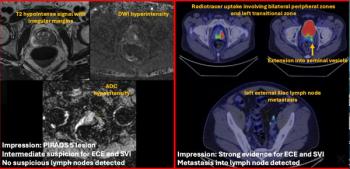A new meta-analysis found that PI-RADS 4 and 5 lesion assessments on magnetic resonance imaging (MRI) as well as prostate-specific antigen density (PSAD) were the only prognostic factors associated with clinically significant prostate cancer (csPCa).
In the meta-analysis, recently published in JAMA Network Open, researchers reviewed data from 72 studies involving a total of 36,366 patients (median age of 65.6 years) with suspected csPCa. All patients had the reviewed studies had transrectal and/or transperineal prostate biopsies, and prostate MRI prior to biopsy, according to the meta-analysis.
The researchers found that 30 percent of unnecessary prostate biopsies could be avoided if clinicians forego biopsy for patients with a PSAD level below .10 ng/mL2 and MRI lesion assessments of PI-RADS 3 or less. By increasing the PSAD level threshold to below .15 ng/mL2, the study authors suggested that 48 percent of unnecessary biopsies could be eliminated.
“Our results suggest that combining PI-RADS with PSAD would reduce the number of unnecessary biopsies and improve the diagnostic yield. Although the stepwise approach based on PI-RADS and PSAD has been used in some institutions to drive decision-making toward prostate biopsy, the current guidelines do not advise against biopsies in patients with a low PSAD and equivocal MRI findings given a lack of level 1 evidence,” maintained lead study author Arya Haj-Mirzaian, M.D., M.P.H., who is affiliated with the Center for Evidence-Based Imaging and the Department of Radiology at Brigham and Women’s Hospital in Boston, and colleagues. “This meta-analysis provides evidence that could potentially influence the evolution of these guidelines.”
Three Key Takeaways
- PI-RADS and PSAD for risk stratification. PI-RADS 4 and 5 lesion assessments on MRI, along with prostate-specific antigen density (PSAD), serve as valuable prognostic factors for clinically significant prostate cancer (csPCa). Integrating both PI-RADS and PSAD can aid in risk stratification and decision-making regarding prostate biopsy.
- Reduction in unnecessary biopsies. The meta-analysis suggests that incorporating PSAD levels and MRI lesion assessments can lead to a significant reduction in unnecessary prostate biopsies. Thresholds for PSAD, particularly below 0.10 ng/mL2, can help identify patients who may not require immediate biopsy, potentially avoiding unnecessary procedures.
- Enhanced diagnostic yield. Combining PI-RADS with PSAD enhances the diagnostic yield for detecting csPCa. The sensitivity rates and negative predictive values are notably high when utilizing specific thresholds for PSAD in conjunction with MRI lesion assessments, which can aid in optimizing biopsy decisions while maintaining diagnostic accuracy.
The combination of no focal lesions, PI-RADS 2 or lower lesion assessments on MRI and a PSAD level less than 0.10 ng/mL2 had a sensitivity rate of 83 percent versus 66 percent for PSAD less than 0.15 ng/mL2 and 35 percent for PSAD less than 0.20 ng/mL2, according to the meta-analysis authors.
Based on findings from eight to 10 studies, the researchers also noted the avoidance of prostate biopsy in patients with PI-RADS 3 lesion assessments and a PSAD less than 0.10 ng/mL2 maintained a sensitivity rate of 85 percent and a negative predictive value of 93 percent.
For patients with no focal lesions, a PI-RADS assessment less than or equal to PI-RADS 3 and a PSAD level less than 0.10 ng/mL2, the meta-analysis authors pointed out a 97 percent sensitivity rate and a 94 percent NPV.
“Despite the high sensitivity, 3% to 5% of csPCa cases may still be missed with this approach. This concern can be addressed by future prospective studies using a lower threshold for PSAD and incorporating additional variables for further risk stratification,” added Haj-Mirzaian and colleagues.
In regard to study limitations, the authors acknowledged that only a few of the reviewed studies examined clinical variables. They also conceded that assessment of combining PI-RADS assessment and PSAD was based on pooled analysis of six to 11 studies with cohorts ranging between 1,454 to 5,288 patients.





























